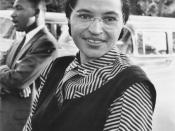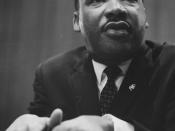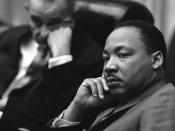Any number of historic moments in the civil rights struggle have been used to identify Martin Luther King, Jr. -- prime mover of the Montgomery bus boycott, keynote speaker at the March on Washington, youngest Nobel Peace Prize laurebate. But single events are less important than the fact that King, and his policy of nonviolent protest, was the dominant force in the civil rights movement during its decade of greatest achievement, from 1957 to 1968.
Martin Luther King Jr. was born in Atlanta on Jan. 15, 1929 -- one of the three children of Martin Luther King, pastor of Ebenezer Baptist Church, and Alberta King, a former schoolteacher. After going to local grammar and high schools, King enrolled in Morehouse College in Atlanta in 1944. He wasn't planning to enter the ministry, but then he met Dr. Benjamin Mays, a scholar whose manner convinced him that a religious career could be very satisfying as well.
Married by then, King returned South to become pastor of the Dexter Avenue Baptist Church in Montgomery, Alabama. Here, he made his first mark on the civil-rights movement, by mobilizing the black community during a 382-day boycott of the city's bus lines. King overcame arrest and other violent harassment, including the bombing of his home. Ultimately, the U.S. Supreme Court declared bus segregation unconstitutional.
A national hero and a civil-rights figure of growing importance, King summoned together a number of black leaders in 1957 and laid the groundwork for the organization now known as the Southern Christian Leadership Conference. King was elected its president, and he soon began helping other communities organize their own protests against discrimination. After finishing his first book and making a trip to India, King returned to the United States in 1960 to become co-pastor, with his father, of Ebenezer...


